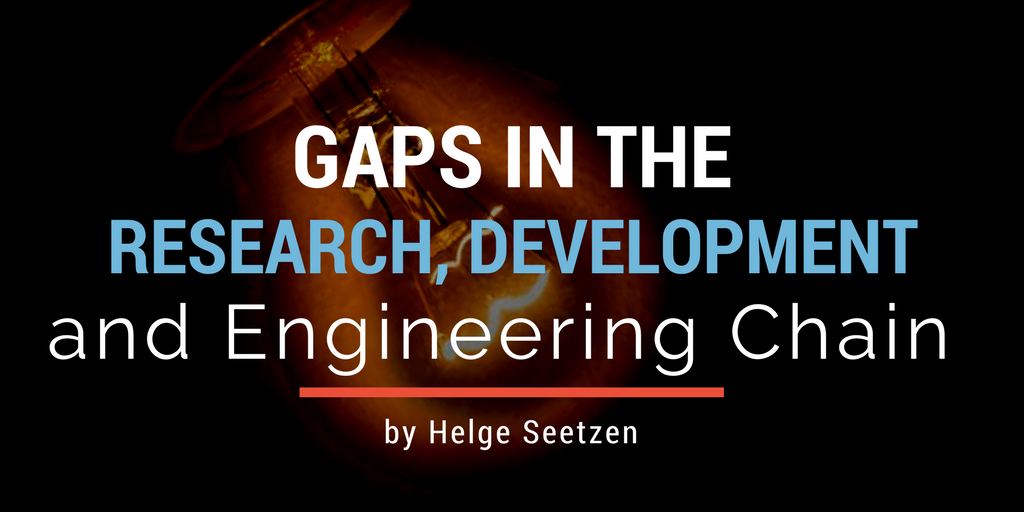I talk a lot about bridging the ‘technology transfer gap’, but there is more than one place where technologies fall to their doom in the development of a new product. When you define each stage in the process (Research, Development and Engineering) you start to see that there are two clear gaps. Between each of these stages, a risky transition occurs. It is not just a few outliers that fail to make each leap; it is the vast majority of inventions. A big part of the reason for this is that very different environments work best for each stage of the R-D-E chain, meaning that technologies do not just need to transition between stages; they typically need to transition between organizations with different cultures and expectations. Any “technology transfer” model needs to take both of these transitions into account. Let’s first briefly define the three stages.
The Research Stage. At the research stage, new ideas are proposed and tested, solutions to problems are sought or discovered, multiple ideas are combined, and inventions result. The best macro-scale model that we currently have for this process is the university. Universities provide the most open and free environments for research to occur, with by a wide margin the most financial resources ( Microsoft Research, probably the largest corporate research entity on the planet, spends about a billion dollars a year on research, which sounds like a lot, but it is still less than even a mid-sized university).
The Development Stage. The task at the development stage is to rapidly risk-reduce an idea emerging from research (the process of innovation). Outlier or extreme cases are considered, many of the scientific elements must be validated, and the fundamentals of how a new technology works will be tested and mapped out. In other words, the technical risk of an invention not working are eliminated or largely brought under control. This is what startups do best due to their focus, speed and flexibility.
The Engineering Stage. Products do not just need to have their technical risks resolved; they also need to be made. That means designing the technology with aspects like cost reduction, manufacturing, production, shipping, and maintenance in mind. Large companies, beyond any doubt, do this the best due to their economy of scale (at least in the case of hardware and similar scalable solutions).
With three steps in the chain there are obviously two transitions. And that’s where the trouble starts.
Transition 1: Research to Development. The usual problem in research to development transitions is that the open, loose form of universities (great for research) is a disaster for development. In development you need focus, speed, agility, and risk money, none of which the university environment typically provides. Inventors, the most likely people to lead the technology’s development at a university, have far too many competing objectives and have much greater incentives and access to resources for basic research and invention then they do for development (for the most part).
At the same time, it is much more difficult to sell an undeveloped invention to a large company, precisely because their emphasis and strength is in engineering. And that is assuming that universities, who are generalist by nature, are able to create and maintain the relationships needed with large corporate structures in specialized industries to pitch their inventions, and understand what the market need for these inventions is.
Transition 2: Development to Engineering. Development Startups face a similarly challenging cultural transition. At first glance that doesn’t seem to be the case. The skill set of startup developers is actually very attractive to big companies – at least in the early courtship days. Startup developers look dynamic, pro-active and goal-oriented. That is why big companies buy startups all the time. After the acquisition, however, this beautiful vision starts to fracture a bit. Many of the best startup producers are hackers at heart. Product engineering on the other hand requires rigour, discipline and process – aspects that a startup will often deliberately suppress in order to progress faster, focusing on the key technical issues. Over time, “dynamic” becomes “can’t focus”, “pro-active” becomes “disruptive” and so forth. That’s why most acquisitions ultimately fail.
TandemLaunch’s mission is to improve the transition efficiency in the R, D, E chain in a way that is consistently beneficial to Canada (more on this in a future post). We accomplish this by 1) identifying key researchers and inventions, 2) leading and providing the resources for the development stage of these inventions, 3) providing industry with a developed invention and the support they need for acquisition, and 4) keeping and creating jobs in Canada.



